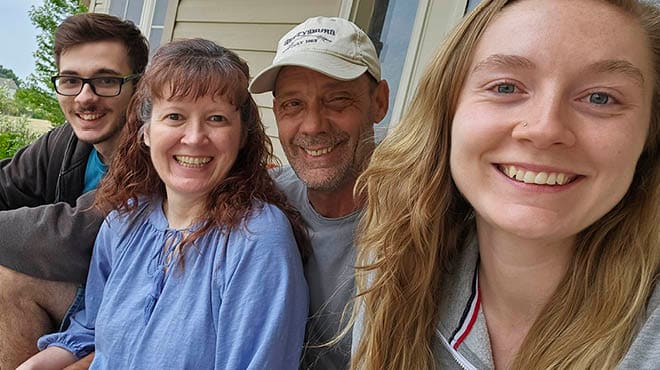Melissa Newman hated having mammograms. Her small, dense breasts made the exams extremely uncomfortable and painful, so she kept putting off her annual mammogram until she felt she couldn't put it off any longer.
For about five years, Melissa had been suffering from a nagging pain just below her left breast. In February 2023, at the recommendation of a friend, she decided to see Jessica Johnson, an obstetrics and gynecology nurse practitioner at Mayo Clinic Health System in Owatonna, Minnesota.
“She took me seriously, was inquisitive and determined to find out what was causing the pain,” said Melissa, who lives in Owatonna and works as an activities assistant at a local assisted living and memory care facility.
During the appointment, Jessica noticed that Melissa hadn't had a mammogram in years, and after she explained her reluctance to get one, Johnson suggested she get a breast MRI.
“I would still get tested, but it would be less painful,” Melissa said. “So I said, 'Let's give it a go.'”
An MRI revealed something concerning. Jessica encouraged Melissa to get a biopsy, but first needed a mammogram. Melissa met Amanda Steinberg, a radiologist in Owatonna, who turned out to be just what she needed.
Overcoming the fear and pain of mammograms
“Mammograms aren't something that many women like to have,” Amanda says. “It's a preventative screening, but you still get one to make sure it's not breast cancer, and it's scary.”
Amanda understands patient fears and reluctance, having experienced the frightening news of a mammogram at the age of 35. She reassures patients, explains what she is doing simply and clearly, distracts them from the pressure and strives to carry out the procedure as quickly and effectively as possible.
That understanding and empathy resonated with Melissa, as did Amanda's technique: She knew that mammograms would be less painful if patients weren't reaching out to grab the machine's handles.
“When you clench or fist, your chest muscles tense up, and clenching those already tense muscles makes the tightness from the pressure even worse,” she says.
And the clenching can create an undesirable “C” shape on the images, so she instructs patients to relax their arms and let them hang at their sides rather than lifting them up and clenching them.
“I've heard from women how good it is,” Amanda says.
Melissa agrees. “She was amazing. I'll never forget her. I wish I'd found her sooner,” she says.
If you look closely you can see the tumor
A mammogram and subsequent ultrasound were inconclusive, so Dr. Johnson ordered a biopsy, which was performed on December 6, 2023. Two days later, Melissa learned that the biopsy confirmed that she had an invasive ductal carcinoma tumor located very close to her chest wall.
“All of a sudden, everything went crazy,” Melissa said.
A whirlwind of pre-op tests and consultations began, and she was informed of her options: partial mastectomy, radiation therapy, or unilateral or bilateral mastectomy.
After discussing her options with her husband, Rick, she opted for a double mastectomy.
“I didn't want to have to get MRIs every six months and worry about it for the rest of my life,” Melissa says.
Melissa met with surgeons at Mayo Clinic Health System and underwent a double mastectomy on Jan. 30. After spending a night in the hospital, she returned home to recover with the help of Rick and their children, Sarah and Joshua.
Before starting hormone-blocking chemotherapy, Melissa's oncologist, Dr. Mina Hanna, ordered a bone density scan, and Melissa was ecstatic to learn that Amanda would be undergoing one, as she had had a very good experience with her mammogram.
“After a patient has a mammogram, I often never find out the results or meet them again,” Amanda says. “When I did Melissa's bone density scan, it felt like we were destined to go on this journey together.”
Genetics, Recovery, and a Night at the Ballpark
At the beginning of her breast cancer journey, Melissa was surprised by her diagnosis because no women in her family had had breast cancer. Tests showed that her cancer was positive for both estrogen and progesterone, but negative for BRCA 1 and 2 markers. Wanting to know more, Melissa underwent thorough genetic testing, which showed nothing to suggest a genetic predisposition to breast cancer.
“I wanted to get additional testing so I could share that information with my daughter and son,” said Melissa, who is now taking hormone-blocking medication and continues to recover.
“Everyone on my care team – Jessica, Amanda, Dr. Hannah, the surgeons and everyone else – were absolutely amazing,” she says.
To celebrate her progress, Melissa threw the first pitch at a recent Mankato Moondogs baseball game during Cancer Survivors Night, hosted by Mayo Clinic Health System.

“It was my first time pitching since my surgery and it was a lot of fun and exciting. I was hoping to pitch well,” Melissa said.
Continuing advances and improvements in mammography
Amanda is proud of Melissa’s breast cancer and her role in helping other patients find it.
“I've always wanted to learn more about mammography and do new things,” she says.
She is especially excited about Owatonna's new 3T MRI machine, which will allow for MRI biopsies and more advanced imaging.
“This equipment will further support breast surgery,” she said, “and allow more patients to receive top-notch care close to home rather than having to travel to Mayo Clinic in Rochester.”
Melissa added that her experience is a good example of why it's important for doctors and health care professionals to take women's health concerns seriously and offer preventive health scans and medical options.
“If I hadn't had a doctor who listened to me and suggested a breast MRI to screen for breast cancer, I probably wouldn't have found out so early,” she says.



